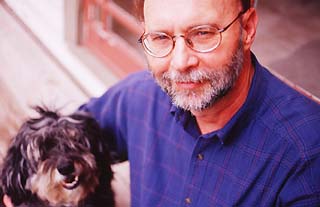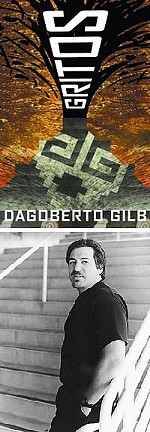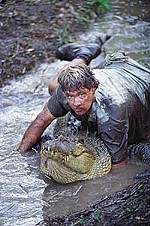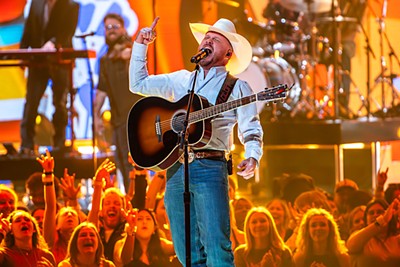As Much Magic as Fact
Stephen Harrigan's The Gates of the Alamo
By David Garza, Fri., March 24, 2000

We tend not to remember the Alamo. True, we've labeled the building a certified "shrine" to our independence, and we've also called it the cradle of our liberty for years. But for all the rhetoric and reverence that is attached to what remains of the fabled old Catholic mission, surprisingly little is known about the actual events that occurred during the days that made martyrs and angels of the very first "Texans." The shrine, it turns out, whispers only a word of its history and sings out so much of its myth. Until now. In the month since the much-hyped publication of Stephen Harrigan's historical novel The Gates of the Alamo, a visible restructuring of the public notion of the fort has seized the imagination of Texas. That dusty old building, whose second claim to fame, after all, came in the form of a supporting role in Pee-Wee's Big Adventure, seems newly polished and far more provocative than anyone could have guessed. While Harrigan's talent in reconstructing an irretrievable moment in history is very nearly flawless, and the many factions and plots that crossed paths in old San Antonio bleed deep with poignancy, the true star of the novel is the iconic brown building itself.
In the minutes before Harrigan recently read from his novel at a local bookstore, for instance, the buzz among some audience members had nothing to do with the author at all, but with the mysterious fate of the Alamo-shaped cake so many had wanted to gaze at. Rumors were passed that the cake had been mishandled, that the edible edifice had somehow been broken. With such a tough act to follow, Harrigan's compelling reading seemed almost a miraculous triumph over a monster that he himself had created.
Still, it's quite a nice monster to have. The novel, currently the bestselling book in Texas according to Amazon.com, is already in its fourth printing. One reviewer in Fort Worth has called it the "first great American novel of the 21st century." And Harrigan has said that he could be persuaded to turn the book into a film -- if he writes the screenplay himself.
All this success from a relatively simple idea on Harrigan's part -- to recall for his readers the state of Texas' first attempts at freedom in the form of a novel. That deceptive goal has proved a difficult challenge: From Harrigan's first boyhood love for the tales of frontiersmen-turned-heroes to the recent publication of his extremely well-researched text, the idea and the image of the Alamo have slowly and painstakingly changed at the hands of historians to reveal far richer and more interesting principal characters, as well as some serious changes in the traditional plot. Plus, the author himself is not who he was when he started the novel.
Fortunately Harrigan, who has also written screenplays, journalism, poetry, essays, and two previous novels, is able to re-create the voices of the men and women who were there in 1836 with a style that is at once trustworthy, detailed, and cinematic. But before he indulges the drama and the glory of every deafening cannon blast and of the valiant, virile William Travis scratching his line in the sand, he seems to forget it all for the span of a second, only to reconstruct it piece by painstaking piece and arrive at a knowledge more haunting and more tragic than history, so far, has ever admitted.
"I knew there was no point in telling [the story] unless you told it in a kind of global perspective," Harrigan says. "The purely Anglo version of it has been told long enough, ad nauseam."
Harrigan first learned of the Alamo via this old Anglo version, of course, and he loved it. Like many visitors to the Alamo in the mid-1950s, then seven-year-old Harrigan was first seduced to the legend of the place by popular adaptations of the swashbuckling heroes and their impeccable virtues -- the noble dignity of a green William Travis, for example, who took command of the operation after Jim Bowie fell ill, and more importantly, the cult of the King of the Wild Frontier himself, David Crockett. Harrigan particularly recalls being inspired by the 1955 film version of Crockett's life story, starring Fess Parker as the Western icon ("the first movie in which we ever saw the hero die"). But what film and television could not prepare him for was the immediacy and gravity of the site seen in person.
"When I saw the actual building itself, I was really kind of overcome by how old and venerable and completely unlike any other building I had ever seen it was. It just seemed absolutely, totally ancient and out of my experience as a kid."
The structures of both the building and its myth impressed him so much, in fact, that by the age of 14, his budding literary mind had already decided that he would someday write a historical novel based on the events surrounding the siege of the Alamo. Of course, he had only the faintest idea of what kinds of characters he would create, and he certainly had no clue that he would later engage in eight years of detailed research into every aspect of the bloody battle, from the types and various uses of the weapons involved to the minutiae of the botanical make-up of the state's gigantic landscape.
But right from the start, he knew that one of his characters would have to be a teenage boy who would march into adulthood against the forbidding backdrop of war. "I couldn't imagine anyone older than me being of any interest," he laughs. More than 30 years later, this character would become Terrell Mott, a central figure of Harrigan's novel. A rare survivor of the conflict in San Antonio de Bexar, Mott quickly loses the idealism that first leads him to Jim Bowie's company of soldiers, and he survives to become a living relic in the first years of the 20th century. As a "wondrously old" man, Mott is perplexed by the public fantasy with the faraway battle, he smirks at the women and girls of Bexar who pelt each other with flowers in their annual restaging of the battle, and he offers occasional pearls of accuracy to anybody willing to listen: "Travis never did draw any line," he confides to a driver near the end of his life.
Having progressed from a boyhood enthralled with such caricatures of glory to an engaging writer who sorts the truth from the myth and enhances them both in the process, Harrigan himself, so much like Terrell, has learned the value of telling a story with at least as much magic as fact.
And just like Terrell, the process has taken a lifetime.
Nowadays, anyone visiting the battle site in downtown San Antonio can purchase an Alamo Limited Edition Millennium Coin for $34.95 in the adjacent gift shop. And a neon-lit Ripley's Believe It or Not Plaza Theater of Wax stands on the ground that was once muddled with the entrails of the Fathers of Texas. Rooms at the Crockett Hotel start at $109 per night just across the street to the east of the shrine. So little of the old Alamo -- the building itself and the battle -- is available for perusal that it seems nearly an impossible task for any writer to attempt to reconstruct an accurate sequence of events, let alone to comprehend the sensation of how the present tense felt in the world of 1836.
"Even small things like what the Alamo looked like," Harrigan says, "it's very hard, even at this state, to convince myself that it didn't look like it does today."
Getting an accurate picture of the roofless, box-shaped mission as it existed at the time of the siege required extended studies of period politics, clothing, agriculture, family tales, nuanced fables of war, documents, and the trails of travel, diaries, maps, and drawings that may or may not honestly show their old faults. At the outset of his research, Harrigan thought he was nearly an expert on the subject of the Alamo simply from having read a number of historical studies on the subject. Writing the novel, however, it quickly became clear to him that numberless details were missing; only hunting them down would make the ambitious novel ring true to the reader.
"You need to portray the world convincingly in great detail. How many buttons on a waistcoat? How do you load a Kentucky rifle? How much does the Brown Bess musket weigh? Shoes or brogans?"
There were times, he says, when he would need to verify 15 to 20 facts in one single paragraph of his text, just to ensure their veracity. Adding to the task of his research was the questionable authenticity and accuracy of many of the materials he needed to study. Recollections and documents relating to that period of time can be difficult to gauge for their honesty, he says -- if they exist at all. To get to the truth, Harrigan sat through lunches with historians, he read dusty books, and of course, he studied the walls of the Alamo.
"The documentation is very thin for how people really lived. A few years later, a few decades later, there would be many more period newspapers or gazeteers. This period is not that way. You have to intuit it."
Even the most telling and well-known of the documents -- William Travis' deeply passionate letters from inside the fort, for instance -- reveal but a portion of the story as it really occurred. His most famous letter, addressed to "the people of Texas and all Americans in the world," expresses the deep conviction of the soldiers awaiting their deaths inside the fort: "I shall never surrender or retreat." Harrigan's depiction of the 26-year-old Travis as he proudly reads his letter aloud, though, is not quite as reverent as one might expect. The woman who stands next to the commander in this scene is Terrell Mott's mother, and she is wounded and vexed by Travis' "arrogance" and his "readiness to doom them all in order that 'all Americans in the world' would not forget his heroism." It is due to Harrigan's skills as a researcher and writer of fiction that this passage succeeds and alarms for its attention to the lives and hearts of all the people involved, conflicted and doomed as they are, as well as its commitment to historical fact (see excerpt).
"In that letter, he says, 'I shall never surrender or retreat,'" Harrigan explains. "The day before, he just tried to surrender [to the Mexican army]. He's spinning it right then, which everybody does. I'm not saying that it's a horrible lie, but human nature is so clearly at work."
This instant "spinning" of each fact by the characters involved, combined with the penchant for rhetoric and desperate ambitions of the men who fought inside the Alamo, the same ambitions that brought them to Texas in the first place, ensured that the tale of the siege would not be forgotten. Travis and his soldiers beg, in effect, that someone -- anyone -- remember the Alamo. And then they want freedom for Texas. In those several days when the Texans were outnumbered and reinforcements either ignored or missed Travis' pleas for help, the chances looked slim.
"I think part of what may have contributed to the myth of the Alamo is a sense of guilt among the other men who felt they had let them down. Travis was sending out these frantic pleas for help, and he never got any," Harrigan says.
So he tried to surrender -- and he lied about it. It's easy to turn against the heroes of the Texas revolution for all their self-interested ambition and moral faults when these facts are so clearly portrayed in both historical and fictional works. But despite the appetites of Travis and others like Jim Bowie, whom Harrigan calls an "out-and-out crook," the author is too clever to be swayed by these acts. He realizes the intense complexity of the webs of individuals and groups involved in the political and social climate of Texas in the 1830s.
"At this level of ambition, everybody is complex. Everybody has mixed motives. Everybody has feet of clay. And that's what's exciting to me as a novelist, is to depict people who are flawed and three-dimensional. I don't think there are any heroes in this book," he says.
If there are no heroes in the book, there are also no villains. Not even Mexican General Antonio López de Santa Anna, whose merciless promise to kill every man in the Alamo shocked even the most devoted of his soldiers. Whose fiery red flag hung from the top of a church signaled "No Quarter" to the people holding the fort. Instead, Harrigan insists on portraying the Mexican side of the battle with respect and, often, a quieted sense of heartbreak. He describes their physical aspects as being not just of a conquering people but also of a "conquered race." To come closer to their minds and desires, Harrigan took lessons in Spanish: "I don't think you really inhabit someone's mind until you can break the code of their language in some aspect."
The language of the Texans, too, can be hard to decipher. Harrigan's most intriguing character is Edmund McGowan, a solitary botanist who rides across the state with his dog Professor, compiling a life-consuming study of the flora of Texas. Throughout the development of the novel and into the heat of the war, McGowan insists on remaining apart from the political struggle engulfing the land and apart, just as well, from the human desires that he feels for Mary Mott. Deeply troubled emotionally and powerless over himself, McGowan becomes a tragic figure who can love but not touch, and he echoes the impotence of the tiny army of men at the Alamo: "If it were possible for me to exchange the life I have lived for another, I think I would do so. And in that life I would want you as my companion." As Edmund McGowan dies later on without knowing the splendor of sex, the heroes die too, never knowing the myth that they forged, never seeing the unreal defeat of the Mexican army.
For those who still cling to the notions of the Alamo myth, with its slightly too-beautiful words and provocative images, with the heart of the tale reaching its peak when Travis draws his test of courage and will in the sand, much of Harrigan's sober extraction of fact from the records of history may be hard to accept. Historians, after all, still disagree about important facts of the siege and debate each other over the authenticity and relevance of many documents and recollections. Ultimately, though, Harrigan's work is not an academic endeavor, but an affecting work of fiction. While knowing the number of buttons on a coat and being able to describe the proper way to load an 1836 rifle may provide the necessary structure of reference for the work, it is ultimately a love story that Harrigan invents, and a bildungsroman, and a story of people trapped in a terrible situation with no way out. If for no better reason, Harrigan remembers the Alamo neither for history nor myth, but for the living and all the mysterious dead. ![]()
Stephen Harrigan will read from The Gates of the Alamo at a benefit for the Howson Branch Library at CC's Coffee House (3110 Windsor) on Sunday, April 2, from 7-8pm.








